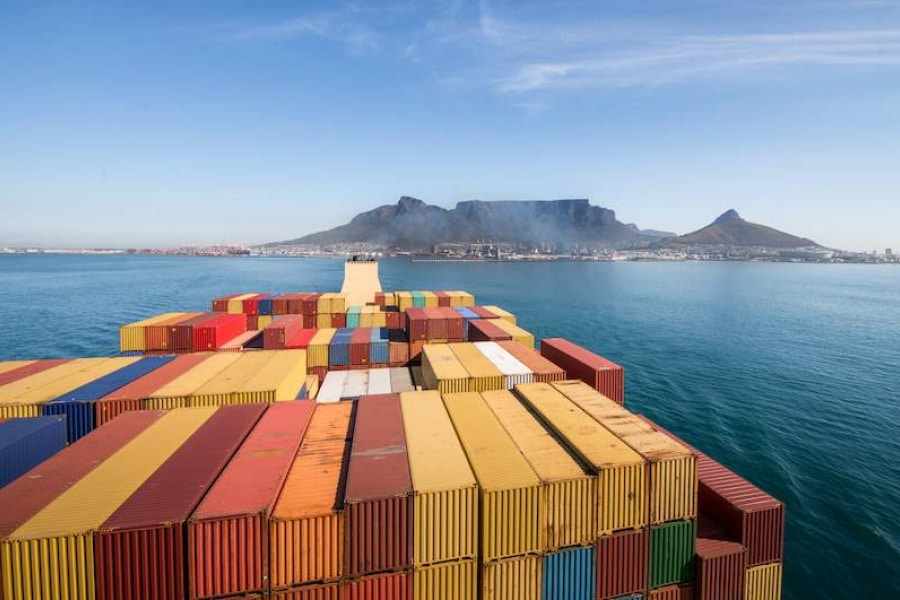Warehousing in Saudi Arabia could play a crucial role in the global warehousing market. The country is at a crossroads between Asia, Europe, and Africa. And by improving its warehousing, it can establish its place as a powerhouse in global trade.
The Saudi warehousing market is growing, and emerging technology and services provide the country with more options to expand. To capitalize on this potential, Saudi Arabia must take stock of its current warehousing market and look for ways that logistics partners like Agility can help it grow.
Status of the warehousing market in Saudi Arabia
In 2016, Saudi Arabia announced its plan to reduce the country’s dependence on the oil market and diversify its economy with a strategy called Vision 2030. To develop the country into a global trading hub, Saudi Arabia is improving its logistics market, including warehousing, and has made strong steps forward in logistics management.
Current warehousing market
According to Ken Research, the Saudi dry warehousing market grew by 2.8 percent between 2015 and 2019 and will continue to grow until at least 2025. The industrial and retail industries are responsible for the largest percentage of this expansion.
The warehousing market is largest in the cities of Jeddah, Riyadh, and Dammam. While Jeddah has a majority of the warehouse revenue share, all three cities play a key role in the expansion of warehousing in Saudi Arabia.
- Jeddah: Jeddah is a port city on the Red Sea. Its warehousing district is close to the Jeddah Islamic Port. Here, the warehouse and logistics supply districts stretch 26.1 million square meters.
- Riyadh: Located in the center of the country, Riyadh is the capital of Saudi Arabia and its main financial hub. Its warehousing districts are primarily near Riyadh’s dry port. The city dedicates 24.5 million square meters to warehousing and logistics parks.
- Dammam: The Dammam metropolitan area is on the Persian Gulf. Its warehousing and logistics parks cluster among four zones to the north, east, south, and west of the city. Currently, the city uses 20.9 million square meters for its warehouses and logistics parks.
Dry freight forwarding
Dry logistics refers to the transport of freight that cannot get wet. The dry logistics market in Saudi Arabia centers primarily in Riyadh and Jeddah. These cities mainly use road transport for dry logistics, with air, sea, and rail following as alternate freight modes.
Dry freight forwarding is a newly stable industry in Saudi Arabia. Between 2015 and 2019, an oil price slump and subsequent economic downturn caused the dry logistics industry’s compound annual growth rate to decline.
However, market analysts from Ken Research forecast that the dry logistics and freight forwarding markets will grow by 1.3 and 0.8 percent, respectively, until the forecast period ends in 2025. This growth is due in part to Vision 2030’s efforts to improve the country’s logistics management.
Warehousing advancements in Saudi Arabia
As the warehousing market in Saudi Arabia expands, companies are developing innovative solutions to streamline their supply chains and increase functionality. Because of this, Saudi Arabia’s warehousing sector is set to keep pace with the rising demand for goods moving in and out of the country.
Key warehousing advancements
To meet the goals outlined in Vision 2030, the Saudi Arabia warehousing market expanded and introduced a number of inventive solutions to push the industry forward.
- Cold storage: In the wake of the COVID-19 pandemic, the need for a safe and effective way to transport and store vaccines was apparent. To meet global demand for a vaccine, Saudi Arabia built a series of warehouses dedicated to storing pharmaceuticals and other perishables. These refrigerated warehouses enable the country to maintain a cold supply chain.
- National Industrial Development and Logistics Program (NIDLP): Saudi Arabia launched NIDLP to improve infrastructure and design new policies related to economic growth. By dedicating financial support to logistics development, NIDLP aims to build Saudi Arabia’s role as a regional logistics hub and improve warehousing.
- Al Khomrah Logistics Zone: The Saudi Arabian ministry of transport opened a logistics zone in Jeddah to support shipping, freight distribution, and transport. This is the largest logistics zone in the country.
- On-demand warehousing: On-demand warehousing enables companies in Saudi Arabia to access warehouse solutions on a temporary basis. On-demand warehousing services negotiate with warehouses to build a network of facilities to increase supply chain efficiency. Companies can lease on-demand warehouse space as a way to cost effectively address shifting demand.
Important technology for warehousing advancements
One of the most crucial elements driving Saudi Arabia’s warehouse market is the country’s embrace of technological advances. These developments help streamline the supply chain and improve warehouse management.
- Saudi blockchain technology: Saudi Arabia aims to implement smart systems to facilitate efficient trade and storage—particularly at seaports, which account for the majority of its trade. To that end, Saudi Customs successfully launched a blockchain pilot to help strengthen the country’s shipping logistics infrastructure. The technology will offer a digital reference of all stages of trade in order to increase transparency across the shipping supply chain.
- Application programming interfaces (APIs): APIs help different order fulfillment, inventory management, and warehouse management software to communicate with each other. This streamlines the warehousing process and enables warehouses to connect with other elements of the supply chain.
- Internet of Things (IoT): The IoT is a boon for warehouse managers, enabling improved inventory management systems and real-time tracking. IoT devices embedded into shipments help companies see where their transported assets are in real time, anywhere in the supply chain. This leads to a faster, more efficient, and more visible flow of goods. By quickly exchanging data with the IoT, warehouses can make all processes more economical.
Challenges with Saudi Arabian warehousing logistics
To emerge as a major player in global logistics, Saudi Arabia must face several obstacles to warehousing expansion. By understanding these challenges, the country is better suited to overcome them.
Major challenges for logistics managers
- e-Commerce: The use of e-commerce has expanded globally and among Saudi Arabian citizens. The market is fast growing, which exposes weaknesses in Saudi Arabian supply chains. Urban centers in Saudi Arabia are not as compact and densely populated as urban environments elsewhere. That lack of density limits efficiency in distribution from the warehouse to the customer. Because of this, suppliers are sometimes unable to meet the demands of e-commerce shoppers for fast shipping.
- Supply chain interruption: COVID-19 revealed vulnerabilities in supply chains. Because their success is dependent upon a variety of uncontrollable variables, warehousing facilities have little power over supply chain interruptions. This means facilities are vulnerable to delays that can result in canceled orders and a lack of customer trust.
- Aging warehouses: Modern, automated warehouses come at a cost. Because of this, many warehousing districts, particularly in Riyadh, contain a large number of aging and outdated structures These are less suited to meet demand and can slow the throughput of goods. Saudi Arabia will need to upgrade these aging warehouses in order to keep up with the global warehousing market.
Solutions for common challenges with warehousing in Saudi Arabia
As challenges arise in warehouse management, companies must develop solutions to meet them. As Saudi Arabia seeks to overcome these challenges, there are many solutions that can help its warehousing networks thrive.
Close proximity to suppliers
Minimizing the distance that materials and goods need to travel can help reduce logistics inefficiencies. Large distances between a company’s suppliers, warehouse facilities, and consumer centers increase lead times, transportation costs, and the risk of supply chain disruption.
Strategic positioning of warehouses can prevent these complications. By positioning warehouses close to suppliers and consumer centers on road, air, and sea transport routes, companies can improve supply chain efficiency. Making these decisions upfront helps companies to cut inefficiencies out of their supply chain before they become a problem.
Warehouse automation
With a growing global demand for goods, it is essential that warehouses effectively manage their inventory, personnel, and equipment. Without reliable warehouse inventory monitoring, companies risk using unreliable data to manage inventory levels.
Additionally, inaccurate personnel or equipment tracking may lead to inefficient warehouse processes. As a consequence, these companies risk failing to deliver goods on time and costly setbacks. Automation in warehouse inventory management systems can alleviate these issues.
The most common way warehouses can implement automation is through warehouse management systems (WMSs) and warehouse control systems (WCSs). While there is some functional overlap between the two, WMSs primarily work to manage personnel and inventory while WCSs focus on equipment.
These systems provide more reliable data on stock levels and workflow to ensure swift order fulfillment. By embracing these systems, Saudi warehouses can more efficiently manage their inventory and product flow.
Logistics parks
One of the most challenging parts of any warehousing operation lies in infrastructure development. Existing logistics parks ease the burden by supplying a fully developed warehouse and logistics infrastructure to companies that need it—logistics parks provide complete logistics services in the storage and distribution of products.
Agility holds over one million square meters of space in Riyadh, Jeddah, and Dammam. Agility’s warehouses in Saudi Arabia are strategically located for easy access to seaports and airports, making them accessible to international customers. These modernized facilities can help companies optimize their logistics.
How Agility can help
Understanding warehousing in Saudi Arabia can help warehouse management companies make a plan for seizing the potential this region has to offer. To meet your warehousing requirements, contact Agility Saudi Arabia, a leading logistics provider in the region.
With Agility Saudi Arabia, regional and global clients can connect with suppliers and markets around the world.
Quick Links
- Status of the warehousing market in Saudi Arabia
- Warehousing advancements in Saudi Arabia
- Challenges with Saudi Arabian warehousing logistics
- Solutions for common challenges with warehousing in Saudi Arabia
- How Agility can help





